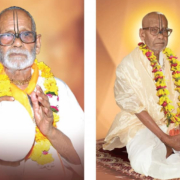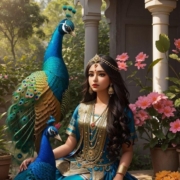Mantra, Nama and Need for Diksha – Part two
By Mahanidhi Swami
Om emanates from Krishna’s flute and manifests first as Gayatri, then as the Vedas, the Vedanta-sutras, and finally as the Srimad Bhagavatam. In its beginning, middle and end the Srimad Bhagavatam stresses the efficacy of chanting Krishna’s holy names. Indeed, the concluding sloka of Srila Vyasadeva’s great treatise recommends chanting Krishna’s holy names: nama sankirtanam yasya, sarva papa pranashanam, pranamo duhkha shamanas, tam namami harim param, “The congregational chanting of Krishna’s holy name destroy all sinful reactions. Offering obeisances to Lord Hari removes all material miseries, therefore I offer my respectful obeisances unto the Supreme Lord Hari.” (SB 12.13.23)
The Hare Krishna maha-mantra, which is a yugala-mantra of Radha and Krishna, expands from Vrndavana as the Kama-gayatri. It becomes the Brahma-gayatri upon crossing the Viraja River. Upon entering the material world the cit-sakti, spiritual potency, of this mantra takes the form of a seed mantra. Then it manifests as Om, which expands into bhur, bhuvah, svah. Again returning to the spiritual world, bhur, bhuvah, svah expand into the Brahma-gayatri, which expands into the purusu-sukta. The purusa-sukta expands into the mantras of the four Vedas (Rg, Atharva, Sama, Yajur). Then the Vedas expand into the Agamas that contain the Pancaratrika writings in 108 different books describing various pancaratrika mantras like the Gopala-mantra and Kama-gayatri.
Srila Prabhupada emphasizes the need for diksa, “If by chanting the Hare Krishna maha-mantra one can attain love of Godhead, then one might ask what then the necessity for taking diksa. Even though the chanting of the holy name is sufficient to enable one to progress in spiritual life to the standard of love of God, one is nonetheless susceptible to contamination because of possessing a material body. Consequently, special stress is given to arcana-vidhi which helps to purify the body and mind.” (SB 7.5.23-24 p.)
Is the effect of chanting the Gayatri mantra the same or different from chanting the maha-mantra? It is the same. Gayatri means that which delivers one from material entanglement. Besides offering liberation, the Gayatri mantras chanted by the Gaudiya Vaisnavas specifically award love of God. Therefore, they have the same effect as chanting Hare Krishna. The kama-bija klim alone can give Radha-Krishna prema, and that of course is the perfection of chanting the Hare Krishna maha-mantra.
But if chanting Hare Krishna is the eternal function of the soul, and the maha-mantra is sufficient to give us Krishna-prema, then why bother with diksa mantras’! Vedic mantras and pancaratrika mantras are only necessary for the conditioned souls. If one were already on the brahma-bhutah (transcendental) platform, then he could easily get all perfection just by chanting the Hare Krishna maha-mantra.
“To chant the holy name of the Lord, one need not depend upon other paraphernalia, for one can immediately get all the desired results of connecting or linking with the Supreme Personality of Godhead. It may therefore be questioned why there is a necessity for initiation or further spiritual activities in devotional service for one who engages in the chanting of the holy name of the Lord.
“The answer is that although it is correct that one who fully engages in chanting the holy name need not depend upon the process of initiation, generally a devotee is addicted to many abominable material habits due to material contamination from his previous life. In order to get quick relief from all these contaminations, it is required that one engage in the worship of the Lord in the temple. The worship of the Deity in the temple is essential to reduce one’s restlessness due to the contaminations of conditioned life.
“Thus Narada, in his pancaratriki-vidhi, and other great sages have sometimes stressed that since every conditioned soul has a bodily concept of life aimed at sense enjoyment, to restrict this sense enjoyment the rules and regulations for worshiping the Deity in the temple are essential. Srila Rupa Gosvami has described that the holy name of the Lord can be chanted by liberated souls, but almost all the souls we have to initiate are conditioned. It is advised that one chant the holy name of the Lord without offenses and according to the regulative principles, yet due to their past bad habits they violate these rules and regulations. Thus the regulative principles for worship of the Deity are also simultaneously essential.” (Cc. Adi 7.77 p.)
The Hare Krishna maha-mantra, the diksa mantras, and the process of worshiping the Deity of Krishna work together to help one quickly attain perfection. As a conditioned soul begins to chant Hare Krishna he becomes cleansed of material contamination and elevated to the platform of goodness. Having attained some internal and external purity, one begins to manifest brahminical qualities. Thus receiving diksa and the appropriate Gayatri mantras, he continues chanting the Hare Krishna maha-mantra along with worshiping the Deity form of the Lord and associating with advanced devotees.
By these practices one eventually rises to the transcendental platform of visuddha-sattva, pure goodness. In other words, the fruit of chanting Hare Krishna is self-purification and attaining the shelter of a bona fide guru. The guru then instructs one in Krishna consciousness and gives diksa. After taking diksa the fruit of the disciple’s nama sankirtana will come as Krishna-prema.
The diksa mantras give us purity and support and keep us from falling down. The function of the diksa guru is complete and successful when the disciple receives, realizes, and attains his siddha svarupa or siddha deha. Although the principal sadhana is chanting the Hare Krishna maha-mantra, Lord Caitanya Himself took diksa, and accepted a ten-syllable Gopala- mantra from His spiritual master Isvara Puri.
This clearly shows the importance of pancaratrika initiation into Vaisnava mantras. Receiving pancaratrika mantras such as Gopala-mantra and Kama-gayatri enhances a devotee’s purification, stills the restless mind, and enables one to worship the Deities. Thus chanting Krishna’s holy names and receiving pancaratrika mantras from a bona fide spiritual master are fundamental to the Gaudiya Sampradaya.
Both mantra and the nama i.e. the Hare Krishna maha-mantra are the same truth because they both contain holy names of the Lord. One part of the same truth is called nama (Hare Krishna maha-mantra), and the other part is called mantra (Gopala-mantra). After obtaining the maha-mantra one is obliged to receive mantra initiation.
By chanting Brahma-gayatri one understands that he is not the body, and becomes liberated from the material conception of life. The chanting of Hare Krishna, however, takes one to the spiritual world and gives prema, provided diksa has been duly accepted from a bona fide spiritual master.
The Gopala mantra raises one to the stage of liberation and, then retires. Krishna’s holy name continues after liberation and helps one attain ecstatic Krishna-prema. By chanting Gopala-mantra, Kama-gayatri, and Gaura-gayatri one attains sambandha-jnana and loses his attachment for sense enjoyment. The diksa mantras enable the sadhaka to chant suddha-nama, the pure name of Krishna.
The Dandakaranya sages performed sadhana of chanting the Gopala-mantra. This mantra established their relationship (sambandha-jnana) with the Lord, and gradually revealed a permanent devotional mellow (sthayi-bhava) in madhurya-rasa. Thus they achieved svarupa-siddhi, the perfectional limit of this world. Next they were reborn as gopis to serve Krishna in His Bhauma Vrndavana pastimes.
At this point of perfection there is no need of chanting the Gopala-mantra, Kama-gayatri, or any other diksa mantras. The refinement of one’s transcendental identity and service will be done by hearing and chanting about Krishna’s pastimes and by associating with Krishna and His eternal servants like Lalita-sakhi and Sri Rupa-manjari.
Diksa mantras such as the Gaura-gayatri, Gopala-mantra, and Kama-gayatri are necessary in the stage of sadhana because they purify one’s chanting of harinama and establish one’s eternal loving relationship with Krishna. Nama-sankirtana, however, is the best practice both in sadhana and in perfection. Liberated souls will no longer chant diksa mantras, but they will forever rejoice in the ambrosial nectar of nama-sankirtana.
In Raga-vartma Candrika, Srila Visvanatha Cakravarti Thakura has clearly stated that those who chant Hare Krishna and worship the Supreme Personality of Godhead, without first having diksa from a Vaisnava guru, will not attain the Supreme Lord. Their chanting, however, will protect them from entering hell. Then in the next birth they will obtain sadhu-sanga, take diksa, and eventually reach the Supreme Lord.
The sastras and the exemplary lives of the previous acaryas show the need for receiving mantras such as the Gopala-mantra and Kama-gayatri in order to advance steadily in pure consciousness and attain the perfection oiKrishna-prema.
The Narada-pancaratra, Yajnavalkya-samhita, and Bhakti-rasamrta-sindhu stress the absolute need for all sadhakas to receive diksa from a bona fide spiritual master. Sri Rupa Gosvami mentions surrendering to and taking diksa from a spiritual master (guru pada asraya, Krishna diksa adi siksanam) as the first two of the sixty-four essential limbs (angas) of sadhana-bhakti.
All the eternal associates of Sri Caitanya Mahaprabhu have followed this process of taking diksa and chanting Hare Krishna along with various diksa mantras. Even Srila Haridasa Thakura, though crowned the namacarya, took diksa from Sri Advaita Acarya according to Advaita Prakash. The duty of the spiritual master is purify and deliver his disciples to prema-dhama Sri Vrndavana by giving them appropriate mantras, mercy and spiritual instructions (diksa and siksa).
Some points have been repeated in the above article for two reasons: Firstly, to stress the importance of receiving diksa. And secondly, to help everyone clearly understand the harmonious relationship between diksa mantras and the Hare Krishna maha-mantra. May everyone perfect their mantra and nama sadhana at attain the wonderful sweet fruit of Krishna prema, and Radha-Madhava’s eternal seva in the kunja vanas of Vraja Dhama.
Excerpt from Gayatri Mahima Madhuri
Sri Harinama Prabhu ki jai!
Jai Jai Sri Radhe!






Leave a Reply
Want to join the discussion?Feel free to contribute!